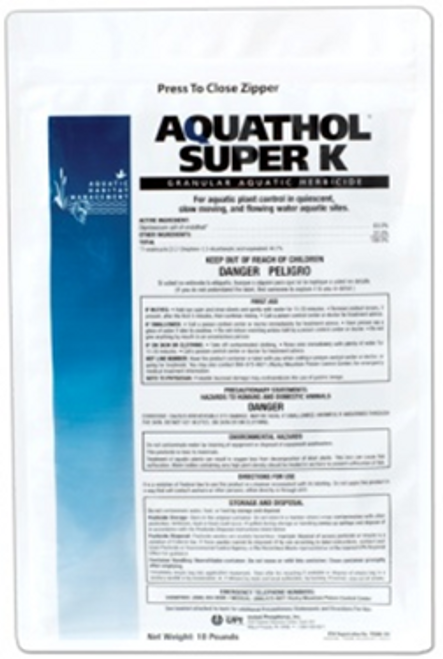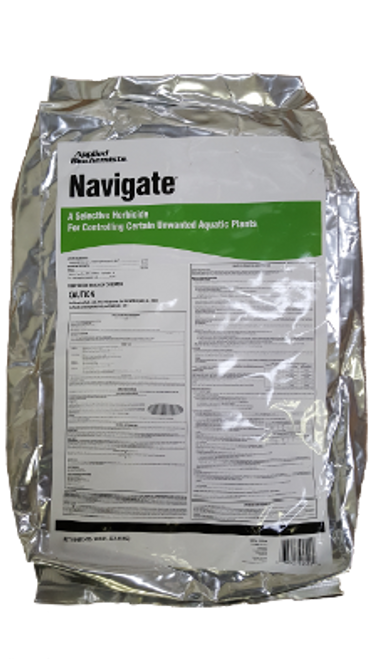Product Overview
Aquathol® K is a concentrated herbicide formulated to effectively eliminate a wide variety of submerged weeds. Aquathol® K begins working on contact to inhibit protein synthesis while breaking down cellular structure or submerged weeds including hydrilla, and curly-leaf pondweed.
Aquathol® K dissipates quickly leaving no residue. The short residual contact time (12 - 48 hours) makes it effective in a variety of applications. Aquathol® K will not bind to suspended sediment or organic matter making it ideal for use when high turbidity and organic debris is present.
Begins to Work on Contact for No-Wait Control
Initial results normally begin occurring in 1 to 3 days. Full kill takes place in 1 to 2 weeks. As weeds die they drop to the bottom and decompose. When applied at labeled rates, Aquathol® K is safe for the environment, and animals including fish, birds and other aquatic life.
|
Aquathol® K Aquatic Herbicide is Labeled for Use Against: Click on your desired weed for more information and alternate control options. |
|||
 |
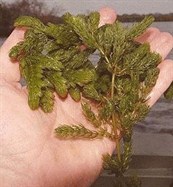 |
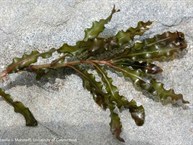 |
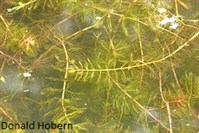 |
|
P. nodosus. |
Ceratophyllum demersum |
P. crispus |
Myriophyllum spp. |
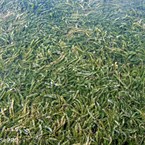 |
 |
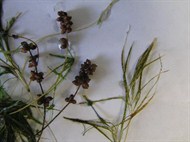 |
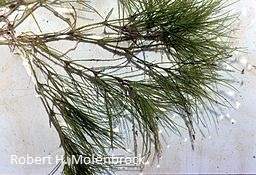 |
|
Hydrilla verticillata |
Myriophyllum aquaticum |
Stuckenia pectinata |
Najas spp. |
*For complete listing of plants controlled by Aquathol® K refer to product label.
Application
Aquathol® K is a contact herbicide; consequently, apply when target plants are present. Aquathol® K should be sprayed on the water or injected below the water surface. It may be applied as a concentrate or diluted with water depending on the equipment. In general, our applicators dilute this product with nine parts water to ensure full coverage of the application site.
The rate of application ranges from 0.45 – 3.2 gallons of Aquathol® K per acre foot of water. Required application rate is dependent on the targeted plant species, size of the treatment area, and depth of the water within the treatment site. Refer to the product label to determine the application rate required for your treatment.
Aquathol® K Example:
- Sample 148 ft. X 148 ft. Curly Leaf Pondweed Marginal Lake Treatment (0.5 Acre)
5 ft. Average Depth
Amount of Aquathol® K required: 1.0 - 3.2 Gallons
*Consult Label for Exact Doses & Important Application Directions.
For Best Results
Aquathol® K has no temperature restrictions but will only work when plants are actively growing. Heavy, out of control growth may require more than one application or physical removal to gain control. Apply early on the morning of a calm, sunny day when the plants are actively involved in photosynthesis.
Aquathol® K may be tank mixed with Reward® and Cygnet Plus.
| Water Use Restrictions | ||||
|
Drinking
|
Fishing
|
Livestock & Domestic Animal Consumption |
Irrigation to Turf & Landscape Ornamentals |
Irrigation to Food Crops and Production Ornamentals |
|
7 days |
0 |
7 days |
0 |
0 |
*For full use restrictions refer to product label.
Chemical Application Best Practices
- Always read and follow the label.
- Treat ponds and lakes in sections, treating no more than ½ of a pond’s surface at a time.
- During hot weather or when treating heavy growth, treat no more than ¼ of your pond at a time.
- Wait the full 14 days before re-applying. This helps lower the risk losing fish due to low oxygen during hot weather or when treating heavy growth.
- Once the algae or weeds have browned & died, use a rake to remove as much dead material as possible.
- Apply Bio Boost Muck Digesting Pellets 5 days after treatment to accelerate the breakdown of dead plant material left behind that would otherwise contribute to the buildup of muck in your pond.
- Use preventative maintenance products to reduce sunlight and/or nutrients.
Notices
Always read and carefully follow the product label.
A WI DNR Aquatic Plant Control Permit or DATCP Fish Farm License is required in WI in order to apply algaecides or herbicides. In addition ponds and lakes with overflows not contained on the property are required to obtain a WPDES permit. Illinois Residents are required to obtain NPDES permits through the Illinois EPA.
Recommendations of pesticide or treatments for specific algae or aquatic plants are provided for general information purposes only - no warranties are expressed or implied.




